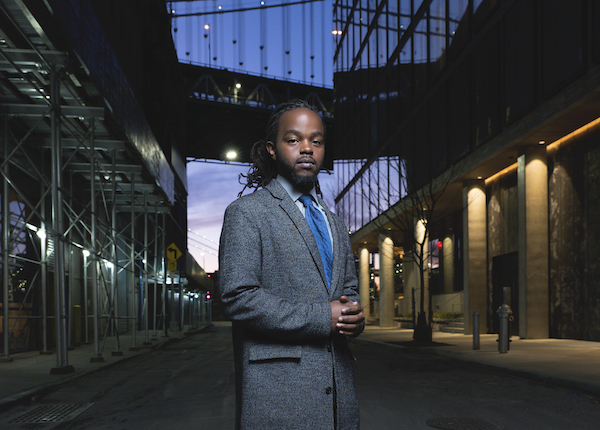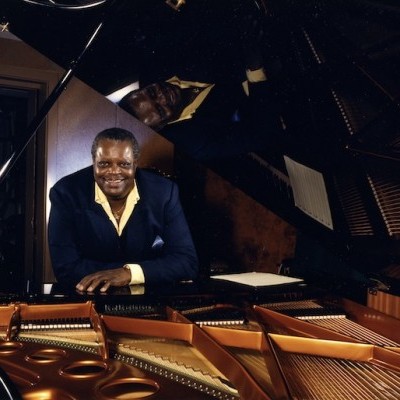Dec 9, 2025 12:28 PM
In Memoriam: Gordon Goodwin, 1954–2025
Gordon Goodwin, an award-winning saxophonist, pianist, bandleader, composer and arranger, died Dec. 8 in Los Angeles.…

Victor Gould experiments with new voices and longstanding collaborators on Thoughts Become Things.
(Photo: Jimmy Katz)“Start as a sideman and prove yourself.”
Those words churned in Victor Gould’s mind as he left Los Angeles for New York in 2011. Gleaning tips from the biographies of Herbie Hancock and other prominent jazz figures, the pianist-composer was on the road, seeking opportunities to play with leaders he admired—who’d appreciate his personal contributions to their projects.
“I’ve taken a lot of time to be a sideman,” said Gould, who’s spent the past several years touring with a diverse group of bandleaders, including trumpeter Jeremy Pelt and vocalist-composer Jazzmeia Horn. This year, though, he’s ready to lead his own international tours.
New York clubgoers have known Gould’s sound for years: the lilt of his lines over a ballad intro and the warm pulses he finds and sits inside of. Thoughts Become Things (Blue Room)—his third recording as a leader—finds Gould poised to garner acclaim beyond the tight circle of artists and listeners who have appreciated his sound for the past decade.
“It all comes down to the triplet; swing music is kind of based on that,” he said, “It goes hand-in-hand: swing and triplet feel, African 6/8 rhythms—Abakuá rhythms.”
Gould’s compositional style identifies connections among music, culture and life experiences. When composing “Inheritance,” a tune off Thoughts, he allowed a single idea to inform the movement of the entire piece. “My first thought for that song was Africa,” he said. “And when I think Africa, I think triplets—6/8. It’s kind of ‘misplaced’ triplets. It doesn’t sound like a 6/8 groove, but it is a 6/8 African groove.”
Interactivity inspires the bandleader, too, as a player and a writer. His compositions, though thoughtfully arranged, leave plenty of room for exploration. Listeners and fellow artists might note a sensitivity in Gould’s expression, and while he questions that descriptor’s association with timidity, he considers the concept of sensitive playing: “[For this recording,] I wanted to leave a lot of room to improvise. And sensitivity is a big part of making that work. Making music spontaneously, all of us had to be sensitive to each other’s inflections and to everything that we hear.”
Thoughts features contributions from a full string quartet and an array of soloists—Pelt and tenor saxophonist Dayna Stephens among them—who help interpret the depth and texture of Gould’s arrangements. Flutist Anne Drummond also appears on the recording. She’d joined the pianist on 2016’s Clockwork (Fresh Sound New Talent), but for the new album, he sought to feature her more integrally.
Because he’d grown up listening to his flutist father’s record collection—Hubert Laws, James Moody, Frank Wess and Yusef Lateef—Gould admitted he always has flute lines playing in his mind.
“I wanted to be as natural as possible,” he said, “to convey the purest melody in my head, exactly the way I was hearing it. And if I’m honest, probably I’m always hearing flute. Anything else would just be trying to imitate the flute.”

Goodwin was one of the most acclaimed, successful and influential jazz musicians of his generation.
Dec 9, 2025 12:28 PM
Gordon Goodwin, an award-winning saxophonist, pianist, bandleader, composer and arranger, died Dec. 8 in Los Angeles.…

Nov 13, 2025 10:00 AM
For results of DownBeat’s 90th Annual Readers Poll, complete with feature articles from our December 2025 issue,…

Flea has returned to his first instrument — the trumpet — and assembled a dream band of jazz musicians to record a new album.
Dec 2, 2025 2:01 AM
After a nearly five-decade career as one of his generation’s defining rock bassists, Flea has returned to his first…

To see the complete list of nominations for the 2026 Grammy Awards, go to grammy.com.
Nov 11, 2025 12:35 PM
The nominations for the 2026 Grammy Awards are in, with plenty to smile about for the worlds of jazz, blues and beyond.…

“It’s a pleasure and an honor to interpret the music of Oscar Peterson in his native city,” said Jim Doxas in regard to celebrating the Canadian legend. “He traveled the world, but never forgot Montreal.”
Nov 18, 2025 12:16 PM
In the pantheon of jazz luminaries, few shine as brightly, or swing as hard, as Oscar Peterson. A century ago, a…